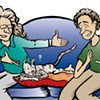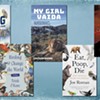Published August 9, 2000 at 6:20 p.m.
Alexandra Jessup Altman judges books by their covers. She also casts a critical eye on their text blocks and end bands. The Calais-based crafter spends countless hours resurrecting old editions that recall an age when a great library was a requisite measure of learning. A trained book conservator, Altman will repair broken bindings and severed spines for anyone who cares enough about their venerable volumes to bring them in for what she calls “humble repairs.”
But in recent years, Altman has been attracting a different kind of business, as a “book artist,” from agents, editors and friends of world-class writers who want to see their own literary works in leather. Increasingly, clients are hiring her to create custom, one-of-a-kind editions — usually given as gifts — for authors such as Thomas Pynchon, David Mamet, Jonathan Galassi and W.S. Merwin. Even Gen. Colin Powell has an Altman original.
For somewhere between $100 and $500, Altman guarantees publishing permanence, whether the job is a wedding album, a baptismal record or a favorite children’s book. “How many gifts are really meaningful?” asks novelist Howard Norman, for whom Altman has doctored and designed at least a dozen books over the years. “Obviously to someone looking at these, there is a sense of posterity. It’s just got that feel to it.”
In the same week Stephen King offered his first novel online, Altman is finishing off three books by — and for — writer Peter Matthiessen. A single antique flatiron sits atop the stack in her studio, which is dominated by pressing contraptions that resemble medieval torture devices. Negotiating tools, books, leather and paper, Altman removes the ironing implement and lays out the three books that comprise Killing Mister Watson, Matthiessen’s trilogy set on an island off the Florida Everglades.
The inside pages are straight from the factory. But Altman has swapped the commercial covers for brown leather ones that she has beveled and scored like elaborate picture frames. Each cover sports a square sketch of lighter brown leather, painted with sepia ink, that is inset so the panel feels flush to the touch. On the back, she has tooled two rows of four-pointed stars along the double-blind lines edging the book. The end sheets — the facing pages on the inside front and back covers — look vaguely Japanese, with a single dark square on greenish-blue paper.
In Altman’s hands, the trio of books by Matthiessen has become a tropical triptych, evoking Conradian images of the old-fashioned jungle. It is obvious from looking at them that her interpretive role in the process goes way beyond the technical cutting, pasting and gluing involved in binding books by hand. Although she is perfectly willing to execute exactly what a client wants — for 30 bucks an hour — most wisely leave the art up to her.
Altman’s color Xerox portfolio is a testament to her versatility. For Panama, a detective novel by Eric Zencey set in 19th-century Paris, she went for a colorful acrylic of the stained-glass window from the Chartres Cathedral. Primitive-looking potato prints found their way into Norman’s Inuit children’s story, The Girl Who Dreamed Only Geese, along with a faux-scrimshaw clasp that held the book together. Her Book of Job — a German translation from the Hebrew — opened from left to right.
Contrasting her approach to the “mundane and predictable bound books” authors get on occasion from their publishers, Norman says, “Alexandra’s work is the result of actually reading and evoking the nature of the book, which is extraordinary.” In the case of Killing Mister Watson, she has even fashioned a slipcase box for the books, covered with pounded bark paper made by Otami Indians. From a distance it looks almost like fur, and, of course, the three books fit perfectly.
You can tell by the way she handles books, and speaks articulately about them, that Altman has a special feeling for the printed word. Born in Germany into a foreign-service family that moved often, she relied on books for “continuity” growing up. “My parents dutifully lugged thousands of books all over the world throughout my childhood,” says Altman, “and then they went back to Washington, and there they are still. Every room has wall-to-wall bookcases.”
Her home in Calais — which she shares amicably with her ex-mother-in-law and two children — is also book-lined. A complete collection of miniature Shakespeare plays and poems stands out amongst the spines in the living room, but Altman insists the good stuff is down the hill. The library assembled by Altman and her ex-husband — a classics scholar, who now lives in Massachusetts — is housed in a separate outbuilding.
“There was no question, even when we got divorced, of breaking up a good library,” she says with characteristic acerbic wit.
“I like looking at all the books and knowing that each is a kind of memory,” Altman says. “I remember who I was when I first read that book, and who gave me a particular book”
Revering published works as “objects” as well as vehicles for ideas, Altman thrived at the Northeast Document Conservation Center in Andover, Mass., where she studied after graduating from Kirkland College. Advocating a “happy blend between functionality and fine binding,” she discovered she enjoyed “taking something that is injured and damaged and trying to make it work again.”
Altman's preference is not to “plop a new binding on an ancient book,” but to maintain as much of the old tome as possible. As an example, she offers a crumbling 19th-century edition suffering from an ailment known as “red rot.” She demonstrates how a new piece of leather can be inserted to reattach a separated spine and cover, leaving the look of the original leather essentially the same. She also makes a pitch for water-soluble paste.
“The idea is, don’t be doing anything that can’t be undone in 200 years without damaging the item,” she says of her conservation efforts. That same careful approach also applies to her weekly book-art sessions with autistic children.
But fixing things with future generations in mind doesn’t change the fact that Altman faces the past every day — specifically, the triumphs and tragedies of bygone bookbinders. Even her tools are secondhand. Early in her career, acting on a tip from an antiquarian book dealer, Altman came upon the discarded equipment of a former bookbinder in southern Vermont. For $600 she bought the lot, including a full collection of decorative hand stamps, rare Parisian paper and German calipers that she still uses today.
“I have a sense of history all the time because my things are old, and from different people,” Altman says, admiring a practice panel of little inlays left behind by her predecessor. She points out with pride that the technology she uses isn’t all that different than it was in the days before best-seller lists. “To me, that is one of the things I like best about working with books,” she says. “It’s pretty much unchanged for the last 500 years.”
What has changed, of course, is the world of publishing. With novels now available through various electronic sources, bibliophiles worry that the book as we know it may cease to exist. Altman, for one, doesn’t ever want to get her information in any other form.
But if “progress” is inevitable, so is book-loving backlash. Given that paperbacks haven’t erased the pleasure of feeling the weight of worn leather on your lap, the Palm Pilot isn’t likely to, either. In other words, Altman is probably secure — along with the other book conservators like the ones at Brown’s River Bindery in Essex — that old books will continue to need mending. Better still, she can count on enough authors wanting their own, new works to stand out in the stacks.
“I know the response from people who have gotten her work is, ‘I didn’t know people still did this.’ It’s almost as if there is an incredulousness because we’re in an automated society,” says Norman. “Here is this person living down the road who is in touch with previous centuries because of her craft. For writers in particular, that has an emotion to it.”
More By This Author
Speaking of...
-

Q&A: Catching Up With the Champlain Valley Quilt Guild
Apr 10, 2024 -

Video: The Champlain Valley Quilt Guild Prepares for Its Biennial Quilt Show
Apr 4, 2024 -

Q&A: Exploring the Haskell Free Library & Opera House With Hannah Miller
Mar 13, 2024 -

Video: Hannah Miller Visits the Haskell Free Library & Opera House in Derby Line, Vt., and Stanstead, Québec
Mar 7, 2024 -

Hancock's Whiskey Tit Press Publishes Books No One Else Will
Dec 20, 2023 - More »
Comments
Comments are closed.
From 2014-2020, Seven Days allowed readers to comment on all stories posted on our website. While we've appreciated the suggestions and insights, right now Seven Days is prioritizing our core mission — producing high-quality, responsible local journalism — over moderating online debates between readers.
To criticize, correct or praise our reporting, please send us a letter to the editor or send us a tip. We’ll check it out and report the results.
Online comments may return when we have better tech tools for managing them. Thanks for reading.














































